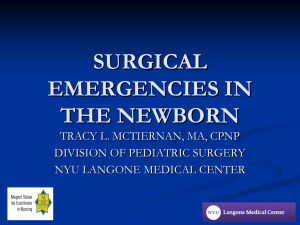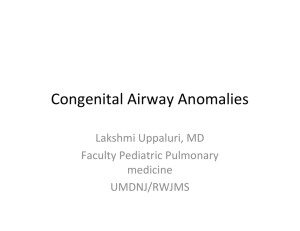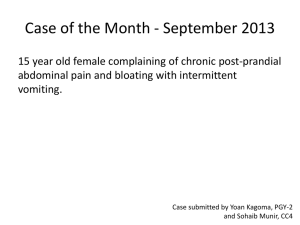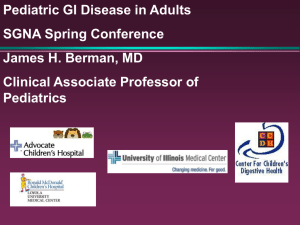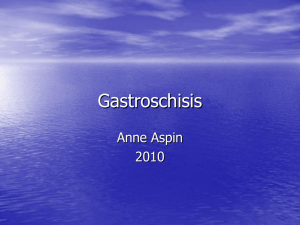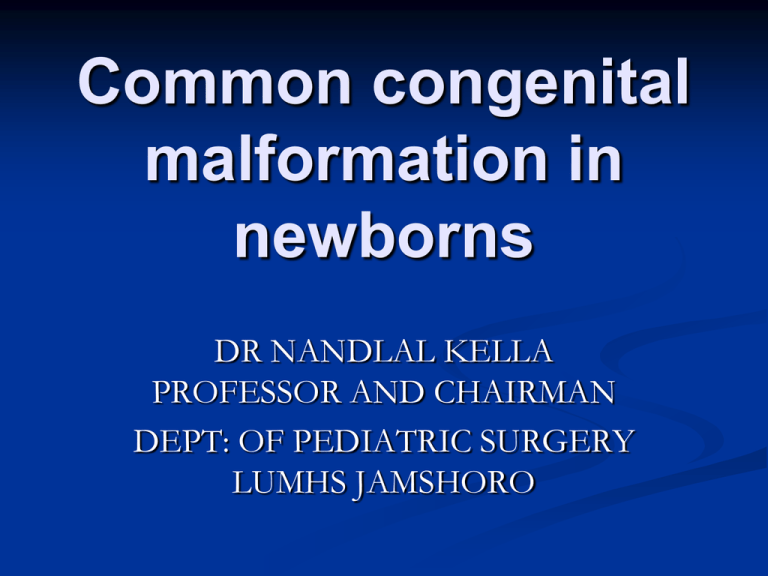
Common congenital
malformation in
newborns
DR NANDLAL KELLA
PROFESSOR AND CHAIRMAN
DEPT: OF PEDIATRIC SURGERY
LUMHS JAMSHORO
Congenital Anomalies
Congenital anomalies are structural
defects present at birth
May or may not manifest clinically at
birth
Represent the most significant cause
of death in infants
Rates of congenital anomalies in risky
pregnancy are higher, most of these
are not compatible with life
Congenital Anomalies
Malformations
Disruptions
Deformations
Sequences
Syndromes
Malformations
Intrinsic errors in morphogenesis that lead to
improper formation of one or multiple organ
systems
Generally multifactorial
Can range in severity from incidental to lethal
Examples:
Micrognathia
Neural tube defects
Malformations
Polydactyly/syndactyly
Cleft lip/palate
Micrognathia
Anencephaly
Disruption
Secondary
breakdown of a
previously normal
structure due to
extrinsic mechanical
factors, not genetic
Localized to a single
area of the body (or
organ)
Does not pose an
increased risk for
Deformation
Abnormalities caused by alterations of the
normal fetal environment, which impair
fetal growth/development
Most common cause is uterine
constriction of fetus affecting growth
during gestational weeks 34-38th
Exacerbating factors include: small
baseline uterine size, malformed uterus,
oligohydraminos, multiple gestations
Most commonly occurs in extremities
since fetal movement is needed for normal
musculoskeletal development
Deformation
Positional bilateral clubfoot
WHAT ARE WE TALKING
ABOUT?
Congenital Diaphragmatic Hernia
Esophageal Atresia
Congenital Intestinal Obstruction
Duodenal Atresia
Ileal and Jejunal Atresia
Meconium Ileus
Malrotation and Volvulus
Hirschsprung’s Disease
Imperforate Anus
Abdominal Wall Defects
Omphalocele
Gastroschisis
Congenital Diaphragmatic Hernia
Incidence
Estimated to be between 1/2000 to 5000 live births
1/3 of infants are stillborn
Males > females in live births
Approximately 80% are on the left side
Occurrence risk in a 1st degree relative ~2%
Congenital Diaphragmatic
Hernia
Pleuroperitoneal
Diaphragmatic Hernia
Uncommon; autosomal recessive trait
Incomplete or failed fusion of pleuroperitonel
membrane
Failure of pleuroperitoneal folds to incorporate
muscle
Located dorsolateral; those on left often result in still
birth or neonatal death
Stomach, spleen and small intestine most common
ETIOLOGY
ETIOLOGY
Cause of CDH is unknown
Increasing evidence that it may be related to
exposure to environmental factors
Associated
Anomalies
Incidence ranges from 10-50%
Skeletal defects ~32%
Cardiac anomalies ~24%
Tracheobronchial tree ~18%
Clinical Signs
Asymptomatic Gravely Ill
Clinical Signs
Respiratory signs > GI signs
Dyspnea, tachypnea, coughing
Pleural effusion, pericardial effusion
Vomiting, gagging , diarrhea
Auscultation and Palpation helpful
Shock (both acquired and congenital)
How Do You Diagnose a Diaphragmatic Hernia?
What you do first is going to depend on
your history and physical examination
Is there history of trauma?
Respiratory problems? CCAM /PNEUMATOCELE
Do you hear borborygmi on thoracic auscultation?
The tools used to diagnose a diaphragmatic
hernia are the same for each type. The results
obtained from your diagnostics will be
different depending on the type of hernia you
have.
ANTENATAL DIAGNOSIS
Diagnosis
Prenatal ultrasound is accurate in 40-90% of cases
Mean gestational age is 24 weeks with some
discovered as early as 11 weeks
Polyhydramnios is present in up to 80% of cases
Presence of loops in chest
After birth the respiratory symptoms are determined
by the degree of pulmonary hypoplasia and reactive
pulmonary hypertension
POST NATAL DIAGNOSIS
Most severely affected infants develop respiratory
distress at birth or 1st 24 hours
EXAMINATION scaphoid abdomen, asymmetry
chest, tracheal deviation, gut sound at chest, apex beat
shifted
US shows bowel loops in chest
Confirmed by plain chest radiograph which
demonstrates loops of bowel in the chest
MANAGEMENT
Key to consider that CDH is a physiologic emergency NOT
a surgical emergency
Early surgery further decreases lung compliance
The post birth transition of vascular and pulmonary function
is prolonged in CDH
In theory, delayed surgery provides additional time for this
transition to occur resulting in a more stable infant
Infants should be intubated and an nasogastric tube passed
Ventilation by mask or Ambu bag is contraindicated
May be managed on a conventional ventilator or a high
frequency ventilator
MANAGEMENT
Management
Key to success is currently thought to be gentle
ventilation with permissive hypercapnea to reduce
barotrauma
Preductal pulseoximetry should be monitored
Metabolic acid base disturbances should be
corrected with fluid management or bicarbonate
administration
ECMO in severe cases - but often NOT necessary
SURGERY
Surgical Management
Timing of surgery is dependent on the infants condition,
ideally anywhere from 5 days to 2 weeks of age
Infant’s ventilator settings are improving and being weaned
Surgical approach is usually through a subcostal incision.
Laparoscopic and thoracoscopic techniques can also be used
Abdominal viscera are gently reduced into the abdominal
cavity
Defect is closed primarily or utilizing a patch
Abdominal wall is closed if possible avoiding increased intraabdominal pressure
Esophageal Atresia and
Tracheoesophageal Fistula
Incidence
EA and TEF are relatively common congenital anomalies
1 in 4500 live births in the US
Male=Female
0.5% - 2% increase risk in newborns with one affected sibling
Risk increases to 20% if more than one sibling is affected
Classification
Esophageal atresia rarely occurs as an isolated
congenital anomaly.
Esophageal atresia alone is due to failure of the
recanalization of the esophagus during the 8th
week of gestation
Gross Classification
TYPES
85% are type C (Distal TEF)
7% are type A (Pure atresia)
4% are type E ( H-type fistula)
Proximal fistula is the least common
Associated Anomalies
VACTERL: vertebral, anal, cardiac, TE, renal, limb
Congenital heart disease is
associated with higher
mortality
VSD is most common
ASD
Tetralogy of Fallot
PDA
Echocardiogram – important
to determine position of aortic
arch
CLINICAL FEATURES
Prenatally
• Predictive value of prenatal ultrasound ~20-40%
• Polyhydramnios (2/3 cases)
• Small or absent stomach bubble
Postnatally• Most infants are symptomatic within the first few hours of life
• Excessive salivation
• Regurgitation of first feed
• Cyanosis with/without feeds
• Respiratory distress
• Inability to pass a catheter into the stomach
• Gastric distention (with distal fistula)
DIAGNOSIS
Diagnosis
Failure to pass NG tube
CXR- tube coiled in upper esophagus
“Pouchogram” with air
Distal air on AXR confirms the presence of a fistula
H-type fistulas are often diagnosed later
Diagnosis
Confirm with AP chest x-ray that
demonstrates the catheter curled in the
upper esophageal pouch.
•Abdominal XR can help distinguish
esophageal blind pouch (no gastric air) from
distal TEF (gastric air)
Diagnosis
Attempt to pass catheter into stomach. Cannot pass more than 10-15 cm.
Diagnosis
When diagnosis is
uncertain or proximal
TEF is suspected, a
small amount of watersoluble contrast
material can be injected
into the esophageal
pouch under
fluoroscopic guidance
(must remove contrast
material immediately to
avoid regurgitation and
aspiration)
Diagnosis
Proximal Esophageal Atresia
Diagnosis- Type E “H type” TEF
MANAGEMENT
Management
Preoperatively
•
•
•
•
•
Minimize complications from aspiration
Suction blind pouch continuously with Replogle tube
NPO/TPN
Upright position of child
Early surgery
Management
Surgery
•
•
•
Surgical ligation of the fistula
Primary anastomosis of the esophageal segments
Primary repair may not be possible if the distance between
esophageal segments is long. Staged procedures have
been performed that include elongation of the esophagus
with circular myotomy, interposition of the colon, and
gastric transposition
To repair esophageal atresia, a thoracotomy incision is made (A). The proximal and distal
esophageal segments are identified (B). The distal fistula is transected (C) and anastomosed to the
upper esophageal pouch (D). (With H-type fistula a cervical approach can be used in most cases)
Post Operative Management
Management
Post Operative
•
•
•
•
•
•
•
•
Adequate fluid resuscitation
Wean ventilator
No deep tracheal suctioning
Avoid bag/mask ventilation
No pacifiers/sucking
Chest tube remains in place for approximately one week
Replogle tube (10 Fr) remains in place +/- one week
Esophagram 1 week post op
Congenital Intestinal Obstruction
Intestinal Atresia
Duodenal atresia
Ileal and jejunal atresia
Meconium Ileus
Malrotation and Volvulus
Hirschspung’s Disease
Imperforate Anus
Duodenal Atresia
Incidence
Most common site of neonatal intestinal obstruction
1 in 6,000 to 10,000 live births
75% of stenoses and 40% of atresias are found in Duodenum
Multiple atresias in 15% of cases
50% pts are LBW and premature
Etiology
No specific genetic abnormality
Increase incidence in siblings
Association with Trisomy 21
ASSOCIATED ANOMALIES
Down Syndrome 28%
Annular pancreas 23%
Congenital heart disease 23%
Malrotation 20%
Esophageal atresia/TEF 9%
Genitourinary 8%
Anorectal 4%
Other bowel atresia 4%
None 45%
TYPES
Pathology
Type I: The most common type
is formed by a membrane
composed of mucosa and
submucosa and obstructs the
lumen. A variation is the
windsock deformity.
Type II: The atretic ends of the
duodenum are connected by a
fibrous cord.
Type III: Complete separation
of the atretic segments. Most
biliary duct anomalies are
associated with this type.
DIAGNOSIS
Prenatally
•
•
•
Diagnosed in 32-57% of patients
Dilated stomach bubble apparent by 3rd trimester
Polyhydramnios in 32-59% of cases
Postnatally
•
•
•
•
•
Symptoms usually appear within the first 24 hours
Recognition of partial obstruction can be delayed
Repeated bilious emesis is characteristic – 85%
Bilious emesis is a surgical emergency until proven
otherwise
Nonbilious emesis is present when the atresia is above the
level where the bile duct enters the duodenum (papilla of
Vater)
DIAGNOSIS
Diagnosis
Radiologic studies
Plain radiograph of the
abdomen will generally
confirm the diagnosis with a
finding of the “double
bubble sign
Upper GI series or barium
enema may be helpful to
differentiate from midgut
volvulus
MANAGEMENT
Management
Replogle tube (10 Fr)
Intravenous fluid resuscitation
Electrolyte correction
CVP line may be considered
Do all base line investigations
If midgut volvulus has been ruled out, surgical correction is
not urgent
Surgery performed is a duodenoduodenostomy or
duodenojejunostomy
Can be performed laparoscopically
Jejunoileal Atresia
Incidence
Has been reported to be as high as 1/3000 live births in the
US
Wide variation in the reported incidence
Males = females
1/3 to ¼ of infants are low birth weight
Higher incidence in African-American infants
Increased risk with maternal use of pseudoephedrine alone
and in combination with acetaminophen
ETIOLOGY
Etiology
Cause is unknown
Most likely associated with a late intrauterine
mesenteric vascular catastrophe
Has been associated with volvulus, intussusception,
internal hernia and constriction of the mesentery in a
tight gastroschisis or omphalocele
PATHOLOGY
Pathology
Equally distributed between the jejunum (51%) and
the ileum (49%)
Atresia is usually single (>90%)
Multiple atresias more often involve the proximal
jejunum
Currently 5 classifications
Type I: Mucosal atresia with intact
bowel and mesenetery
TypeII: Blind ends separated by a
fibrous cord
Type III(a): Blind ends separated by
a V-shape mesenteric defect
Type III(b): Apple-peel atresia
Type IV: Multiple atresias (string of
sausages)
DIAGNOSIS
Clinical Signs
•
•
•
•
•
Polyhydramnios - more commonly seen in proximal
atresias
Bilious emesis – SURGICAL EMERGENCY UNTIL
PROVEN OTHERWISE
Abdominal distension
Jaundice
Failure to pass meconium
Radiologic
•
•
Studies
Supine and erect abdominal films
Contrast enema or UGI
PRE OP MANAGEMENT
Management
Replogle tube (10 Fr) to continuous suction
Intravenous fluids
Electrolyte correction
PICC line placement
Operative procedure depends on defect
• May require multiple anastomoses
• May require ostomy
• May require tapering of proximally dilated intestine
Meconium Ileus
Incidence
Almost always associated with cystic fibrosis
Reported to be the presenting symptom in 15-20%
of cases
Incidence is reported to be 30-40% in all patients
with cystic fibrosis
PATHOLOGY
Simple meconium ileus
• Small intestine mucous glands produce overly
thick secretions
• Meconium formed is abnormally viscid, sticky
and adherent
• Proximal ileum dilated with thick, sticky
meconium
• Distal ileum and colon are collapsed and
obstructed by thickly packed round mucous plugs
– rabbit pellets
COMPLICATED MI
Complicated meconium ileus
•
In utero dilated proximal intestine volvulizes
•
Early in gestation may cause one or more atresias
•
Late in gestation infants may present with
perforation -> meconium peritonitis
DIAGNOSIS
Diagnosis
Prenatally
•
•
Prenatal history of cystic fibrosis
Polyhydramnios is reported in ~20% of mothers – more common
finding in complicated meconium ileus
Postnatally
•
•
Intestinal obstruction is evident 24-48 hours after birth
-> abdominal distention
-> bilious emesis
-> failure to pass meconium within 48 hours
Complicated meconium ileus presents at or shortly after birth
-> severe abdominal distension
-> abdominal wall may be red and inflamed
-> extremely ill appearing infant
Radiologic Studies – Simple MI
•Plain radiographs
Varying sized loops
of distended bowel
Absence of air fluid
levels
Soap bubble
appearance particularly
in the right lower
quadrant
CONTRAST
•
Contrast Enema
Water soluble contrast
Microcolon
Pellet-like meconium
when contrast is refluxed
into the terminal ileum
Curative in 30% of
patients
Radiologic studies – Complicated MI
•
Plain film
Areas
of calcification (calcified meconium)
Large dense mass with a rim of calcification – cystic
meconium peritonitis
Intraperitoneal calcifications can occur within 4 days of
perforation
•
Contrast enema may not be necessary
MANANGEMENT
Management – Simple MI
Aggressive fluid resuscitation
Naso/orogastric tube to suction
Hyperosmolar contrast enema (Gastrografin)
•
May be curative in 30-60% of patients
Goal of surgery is to completely evacuate the
obstructing plugs and meconium
•
•
•
Enterotomy and irrigation
Intestinal resection and primary anastomosis
Ostomy may be necessary
Intestinal Malrotation and Volvulus
Incidence
Occurs in 1/500 live births
Male to female ration is 2:1 in neonatal presentation
No sexual predilection in patients over 1 year
As many as 40% present within the first week
50% present by 1 month
75% present by 1 year
Etiology
Rotation and fixation of the intestine takes place
during the first 3 months of gestation
As rotation begins, the intestine moves outside the
abdomen
At 10 weeks of gestastional age the intestine returns
to the abdomen
Normal mesenteric attachment extends from the
ligament of Treitz to the cecum
Ascending and descending colon are fixed
retroperitoneally
ETIOLOGY
Etiology
Malrotation is when the normal process of rotation
is arrested or deviated at various stages
Anomalous fixation may also occur
Dense fibrous bands extending from the cecum and
right colon across the duodenum to the
retroperitoneum may form – Ladd’s Bands
PATHOLOGY
Pathology
Midgut may be supported by a narrow pedicle that contains
the entire blood supply
Narrow pedicle predisposes the bowel to a clockwise twisting
from the duodenum to the transverse colon
Distension and peristalsis may initiate torsion of the intestine
on the pedicle - Volvulus
Acute midgut volvulus occurs when the blood supply to the
midgut is disrupted by the torsion
Vascular obstruction and necrosis of the complete midgut
develops rapidly
Ladd’s Bands can cause a mechanical duodenal obstruction
without vascular compromise
DIAGNOSIS
Diagnosis
Clinical symptoms
•
•
•
•
•
Most frequent symptom is bilious emesis
Pain and irritability in the toddler or older child
Abdomen is soft and non-tender to palpation initially
Becomes distended and tender with strangulation of
bowel
Stool may be bloodstained
Radiologic studies
•
•
Abdominal radiographs may show a dilated duodenem
with a fluid level, however can be read as normal in 20%
of cases
Barium enema is unreliable – position of cecum varies
RADIOLOGY
Diagnosis
•
Radiologic studies
Upper GI series with small bowel follow through is
the most reliable – 96% specificity in one report
Dilated
duodenum with a typical corkscrew appearance
Absence of Ligament of Treitz
Small bowel on right side of abdomen
UGI may be misleading if duodenal obstruction is
complete (also seen with duodenal atresia)
MANAGEMENT
Management
Once the diagnosis is made on a symptomatic child,
the patient should be taken to the operating room
immediately
Ladd’s procedure is performed
•
•
•
•
•
Derotation of the bowel
Division of the Ladd’s bands if present
Widening the small bowel mesentary by lysis of congenital
adhesions
Return the bowel to a position of nonrotation
Appendectomy
Hirschsprung’s Disease
CONGENITAL MEGACOLON
SHORT SEGMENT 80%
LONG SEGMENT 11-25%
TOTAL COLONIC 3-10%
EXTENSIVE COLONIC AGANGLIONIS .4-1%
SKIP LESION
ULTRA SHORT
ETIOLGY
Etiology
Cause of Hirschsprung’s Disease is unknown
Features of the disease are suggestive of a complex
pattern of inheritance
RET gene mutation was found in~ 35% of sporadic
cases and 49% of familial cases
Pathology
Absence of ganglion cells in the distal intestine is the
hallmark of the disease
Ganglion cells are absent in the submucosal plexus and
intermuscular plexus
Hypertrophy of nerve bundles
Diagnosis
Clinical findings
•Delayed passage of meconium within the first 48 hours
of life
•95 % of full term infants stool within the first 24 hours
•Remainder will stool by 48 hours
•This history may be absent in 6 to 42% of patients
•Constipation
•Abdominal distension
•Failure to thrive
•Hirschsprung’s Disease should be considered in any
child who has a history of constipation dating back to
the newborn period
Diagnosis
Radiologic studies
Xray plain abdomen
Gastrograffin enema
Rectal bipsy
•In any infant with a suspected diagnosis of
Hirschspung’s Disease no rectal stimulation of
any kind should be performed
Management
Treat as intestinal obstruction
Primary pull-through procedure
Transanal approach for normal segment disease
Intraoperative biopsies are performed to confirm the
transition zone
Procedure may be performed with laparoscopic
assistance
Older children may require a colostomy first with the
definitive procedure performed several weeks later
Definition of Anorectal malformation
Absence of anal opening is
considered as imperforate
anus.
When anus is not located at
its proper place , it is called
as ectopic anus /perineal
fistula
Most of the time
,imperforate anus is
asociated with fistula eg
rectovestibular,rectovaginal
fistula and rectourethral
fistula and
rectovesicalfistula.
Pathology
Deformities are divided into high, intermediate and low
Thorough clinical examination
In females 95% have fistula. No surgical emergency
In males : this is surgical emergency until and unless fistula
All the patient should be given 16-24 hours to reach air air
at rectum to confirm types of anomaly until there is no
fistula.
Diagnosis
All suspected cases of anorectal malformation require a
thorough perineal examination
Infants should be given sufficient time to pass meconium
Two positional radiographs may be helpful
Invertograms are not useful
Figure 341-3 Imperforate anus in females. A, Vestibular fistula. B, Cloaca. (From Peña
A: Atlas of Surgical Management of Anorectal Malformations. Springer-Verlag, New York, 1989,
pp 50, 60.)
Figure 341-2 Imperforate anus in males. A, Low lesions. B, High lesions. (From
Peña A: Atlas of Surgical Management of Anorectal Malformations. Springer-Verlag, New
York, 1989, pp 7, 26.)
Management
IV fluids
Replogle tube (10 Fr)
Workup for VATER syndrome
•Echocardiogram
•Dedicated spinal films/spinal ultrasound
•Renal ultrasound
Newborn Male
Perineal Inspection
Perineal fistula
Rectal gas below coccyx
No associated anomalies
Rectal gas above
coccyx
Associated defects
Abnormal sacrum
Anoplasty
PSARP +/- colostomy
Flat bottom
Colostomy
Adapted from Pena, A, Levitt, M: Anorectal Malformations. In Grossfeld, J, O’Neill, J, et al (ed) Pediatric
Surgery. 6th Ed.
Management
Operative repair
•Anoplasty for perineal fistulas
•Posterior Sagittal Anorectoplasty - PSARP
Electrical stimulation of the perineum to
evaluate sphincter contraction
Midline sagittal incision dividing the sphincter
mechanism into 2 equal parts
Important nerves and vessels do not cross the
midline
•Colostomy with delayed PSARP for high imperforate
anus
Management
Postoperatively
•Oral feeding may begin when the infant is awake enough
•Antibiotics for at least 24 hours
•Rectourethral fistula – foley cathether for 7 days
•Rectal dilation program is begun ~ 2 weeks post op
•Colostomy, if present, is closed when anal caliber is
adequate (~12Fr Hegar dilator in a 1-4 month old)
•Diligent perianal care – protective barrier cream
•Multiple stools initially
Abdominal Wall Defects
OMPHALOCELE
GASTROSCHISIS
EXSTROPHY BLADDER
CLOACAL EXSTROPHY
ABD WALL DEFECT
Gastroschisis
Omphalocoele
Gastroschisis
Omphalocoele
Incidence
1:15,000-30,000
1:6,000
Peritoneal
covering/sac
Absent
Present
Location of defect
Periumbilical
Within the umbilical
cord
Herniated bowel
Matted, edematous
Normal
Associated
anomalies
Low (10-15%)
High (40-60%)
Intestinal atresia (15%)
Congenital heart ds.
Beckwith-Weidemann
syndrome
Omphalocele
Gastroschisis
Herniated
Bowel
Protected
Edematous and
matted
Other organs
Liver often in sac
Remain in abd.
IUGR
Less common
Common
NEC
If sac is ruptured
18 %
Omphalocele
Gastroschisis
Herniated
Bowel
Protected
Edematous and
matted
Other organs
Liver often in sac
Remain in abd.
IUGR
Less common
Common
NEC
If sac is ruptured
18 %
Assoc..
Anomalies
Omphalocele
Gastroschisis
Overall
55% to 80%
10% to 15%
37 % (Midgut volvulus
18 % (stenosis and
GI
Meckel’s Diverticulum, atresia,
duplications)
20 %
Cardiac
Trisomy
30 %
atresias)
2%
No increase
Diagnosis
Usually antenatally by ultrasound
In a European study sensitivity of ultrasound was 75%
Usually detected at 18 weeks +/- 6 weeks
Management of Omphalocele
May be delivered vaginally
Placed on mechanical ventilation
Replogle (10 Fr) tube should be placed
Intravenous fluids
Prophylactic antibiotics
Cardiology evaluation and echocardiogram – this should not
delay surgery
Surgery
•Small defects may be closed primarily
•More likely a staged procedure with the placement of a silo
Silo is reduced daily if tolerated at the bedside – ideally
reduced in 7 days
Operating room for final closure
Management of Gastroschisis
May be delivered vaginally
Cover exposed bowel with warm saline moistened sterile
dressing
Replogle tube (10 Fr)
Support of the premature infant
Monitor for fluid and heat loss
Should be taken to the operating room ASAP
The faster the bowel can be reduced the more likely
primary closure can be achieved
If reduction and primary closure can not be achieved a
silo is placed
Post operatively requires adequate fluid resuscitation
Contents of omphalocele after sac is removed
In Summary
BILIOUS EMESIS IS VOLVULUS UNTIL
PROVEN OTHERWISE
History and plain films will guide sequence of
further studies
Remember the associated anomalies
THANKS
THANK YOU
Inguinal Hernia
Indirect 99%
1% to 3% of all children
20% to 25% in preterm baby
R 60% L 30% Bilateral 10-15%
Males to females ratio is 6:1
Present as bulge in the groin, scrotum, or
labia.
A reliable history is sufficient to make
the diagnosis, even if the hernia cannot
identify.
An incarcerated inguinal hernia presents
as a mass in the labia or scrotum that
does not reduce spontaneously.
What embryological events account
for this abnormality?
Failure of the processus vaginalis to close (it
remains patent).
What are your recommendations to
the parents?
The hernia should be repaired electively; the
parents should be warned about possible
incarceration in the meantime.
If at the time of your examination the
child were irritable and the mass
irreducible, what would be your
approach?
Attempt manual reduction (use sedation if
necessary); emergency surgery if
unsuccessful.
Hydrocele
It is a collection of fluid in the tunica
vaginalis.
Localized to the scrotum.
Fluctuation of the scrotal size during
the day.
Types: communicating &
noncommunicating hydrocele
Transillumination is not a reliable
Do not aspirate
Treatment: Observation for
6months to one year of age, before
surgery.
Undescended Testis
Undescended testis occurs in 30% of
premature boys, 3.4% of full-term
boys, 0.8% of 1-year-olds.
must be distinguished from a retractile
testis.
Complication : Failure of the testicle to
produce viable sperm; malignant
degeneration of the testicle;
predisposition to torsion and traumatic
injuries; there is likely to be an
associated inguinal hernia.
Orchiopexy is performed after six
months of age.
Umbilical Hernia
6 to 10 times higher in blacks than
in whites.
Most umbilical hernias close
spontaneously within the first 3
years of life .
Small-diameter umbilical hernias
close earlier than large-diameter
umbilical hernias.
Claims that strapping helps cure
umbilical hernia are not supported
by available data.

